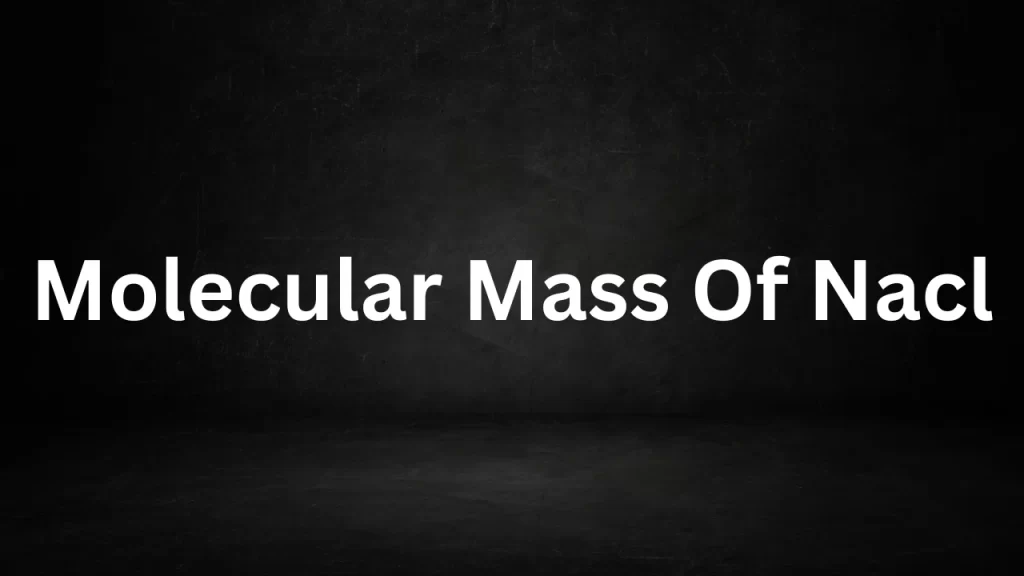Tag: sodium chloride g mol
Molecular Mass Of Nacl
Molecular Mass Of Nacl: Sodium chloride, commonly known as NaCl, is a ubiquitous chemical compound that holds a prominent place in both our culinary and scientific worlds.
Its molecular mass, often overlooked in daily life, plays a crucial role in various scientific, industrial, and health-related contexts. Let’s delve into the fundamentals of the molecular mass of NaCl and explore its significance.

Molecular Mass Of Nacl
Molecular Mass: The Foundation
Before we delve into the molecular mass of NaCl, it’s essential to understand what molecular mass means. Molecular mass, also known as molecular weight or molar mass, is the mass of a molecule, typically expressed in atomic mass units (u) or unified atomic mass units (AMU). It represents the sum of the atomic masses of all the atoms in a molecule.
Composition of NaCl (Sodium Chloride)
NaCl, or sodium chloride, is a simple ionic compound composed of two elements:
- Sodium (Na) with an atomic mass of approximately 22.98977 u.
- Chlorine (Cl) with an atomic mass of approximately 35.453 u.
Calculating the Molecular Mass of NaCl
To find the molecular mass of sodium chloride, we add the atomic masses of its constituent elements:
Molecular Mass of sodium chloride = (Atomic Mass of Na) + (Atomic Mass of Cl) Molecular Mass of sodium chloride ≈ 22.98977 u + 35.453 u ≈ 58.44277 u
Rounded to four decimal places, the molecular mass of NaCl is approximately 58.4428 atomic mass units (u).
Significance of NaCl’s Molecular Mass
Understanding the molecular mass of sodium chloride is of paramount importance in various fields and applications:
- Culinary and Food Science: In the culinary world, sodium chloride, or table salt, is a primary seasoning and preservative. Knowledge of its molecular mass is essential for accurately measuring and controlling salt content in recipes and food products.
- Chemical Reactions: In chemistry, sodium chloride is often used as a reagent or in the preparation of other chemicals. Its molecular mass is crucial for stoichiometry calculations in chemical reactions.
- Medicine and Health: Sodium chloride is used in intravenous (IV) fluids and saline solutions for medical purposes. Understanding its molecular mass is vital for dosage calculations and patient care.
- Manufacturing: In various industries, sodium chloride is utilized in processes such as water treatment, chemical manufacturing, and metallurgy. Precise measurements of its molecular mass are essential for quality control and process optimization.
- Geology and Earth Science: Sodium chloride is a common mineral found in salt deposits and in seawater. Its molecular mass is used in geological studies and the analysis of water composition.
- Environmental Science: The study of salt concentration in natural bodies of water and its impact on aquatic ecosystems relies on an understanding of the molecular mass of sodium chloride.
Conclusion
- The molecular mass of sodium chloride (sodium chloride), approximately 58.4428 atomic mass units (u), is a fundamental property of this everyday compound. While often taken for granted, sodium chloride’s molecular mass underpins its widespread use in food, chemistry, medicine, and various industrial applications. Whether you’re seasoning your meal or conducting scientific experiments, recognizing the importance of sodium chloride molecular mass enhances your understanding of its role in our world.
Read More
- Molecular Mass Of Naoh
- Molecular Mass Of Nitrogen
- Molecular Weight Of Glucose
- Molecular Mass Of Oxygen
- Difference Between Light Microscope And Electron Microscope
Frequently Asked Questions (FAQs) Molecular Mass Of Nacl
1. What is the molecular mass of NaCl (sodium chloride)?
The molecular mass of sodium chloride, also known as sodium chloride or table salt, is approximately 58.4428 atomic mass units (u). This value is obtained by adding the atomic masses of the constituent elements in the compound: sodium (Na) and chlorine (Cl).
2. Why is it important to know the molecular mass of NaCl?
Understanding the molecular mass of NaCl is crucial in various scientific, industrial, and everyday applications. It is used in chemical reactions, food preparation, medical treatments, and manufacturing processes.
3. How is the molecular mass of NaCl calculated?
The molecular mass of NaCl is calculated by adding the atomic masses of its constituent elements, sodium (Na) and chlorine (Cl). The atomic masses can be found in the periodic table, and their sum gives the molecular mass of sodium chloride.
4. Can the molecular mass of NaCl vary in different contexts?
No, the molecular mass of sodium chloride remains constant because it is a fixed chemical compound with a specific composition. It does not change in different contexts or environments.
5. What is the significance of NaCl’s molecular mass in the culinary world?
In cooking and food science, understanding the molecular mass of sodium chloride is essential for accurately measuring and controlling salt content in recipes. It influences flavor, texture, and preservation in various food products.